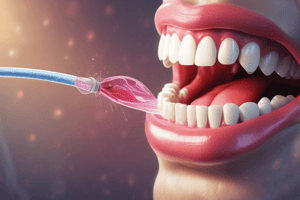Podcast
Questions and Answers
Which of the following is a characteristic feature of erythroplakia?
Which of the following is a characteristic feature of erythroplakia?
- Granular appearance
- Thick and adherent plaques
- Surface projections
- Soft and velvety texture (correct)
Which virus is less commonly associated with chronic infections that may lead to oral potentially malignant disorders?
Which virus is less commonly associated with chronic infections that may lead to oral potentially malignant disorders?
- Syphilis
- Candida albicans
- Epstein-Barr virus (correct)
- HPV
What does leukoplakia denote?
What does leukoplakia denote?
- A non-clinical term for white patches on oral mucosa
- An infectious lesion on the oral mucosa
- A clinical term for white plaque or patch on oral mucosa (correct)
- A specific histopathologic tissue alteration
What is a common site for erythroplakia?
What is a common site for erythroplakia?
Which of the following is a characteristic feature of thick or fissured leukoplakia?
Which of the following is a characteristic feature of thick or fissured leukoplakia?
What is the primary effect of alcohol in relation to the oral mucosa?
What is the primary effect of alcohol in relation to the oral mucosa?
What is an intrinsic factor contributing to oral potentially malignant disorders?
What is an intrinsic factor contributing to oral potentially malignant disorders?
What distinguishes proliferative verrucous leukoplakia from other clinical variants of leukoplakia?
What distinguishes proliferative verrucous leukoplakia from other clinical variants of leukoplakia?
Which of the following is a characteristic feature of speckled leukoplakia?
Which of the following is a characteristic feature of speckled leukoplakia?
What is the clinical appearance of mild or thin leukoplakia?
What is the clinical appearance of mild or thin leukoplakia?
What distinguishes actinic cheilitis from other clinical differential diagnoses?
What distinguishes actinic cheilitis from other clinical differential diagnoses?
Which of the following is NOT a clinical feature of actinic cheilitis?
Which of the following is NOT a clinical feature of actinic cheilitis?
What is the histopathological feature commonly seen in actinic cheilitis?
What is the histopathological feature commonly seen in actinic cheilitis?
Which condition is completely reversible upon discontinuation of the tobacco habit?
Which condition is completely reversible upon discontinuation of the tobacco habit?
What is the characteristic oral mucosal presentation in oral submucous fibrosis?
What is the characteristic oral mucosal presentation in oral submucous fibrosis?
Which feature is NOT associated with nicotine stomatitis?
Which feature is NOT associated with nicotine stomatitis?
Which condition is characterized by chronic progressive scarring of the oral mucosa?
Which condition is characterized by chronic progressive scarring of the oral mucosa?
What is a common etiological factor for actinic cheilitis?
What is a common etiological factor for actinic cheilitis?
Which feature is characteristic of solar (actinic) elastosis?
Which feature is characteristic of solar (actinic) elastosis?
What is a common feature of nicotine stomatitis histopathology?
What is a common feature of nicotine stomatitis histopathology?
Which statement about oral potentially malignant disorders (OPMD) is correct?
Which statement about oral potentially malignant disorders (OPMD) is correct?
Which text would provide relevant information for understanding the histopathological aspects of oral epithelial dysplasia?
Which text would provide relevant information for understanding the histopathological aspects of oral epithelial dysplasia?
Which feature is NOT characteristic of oral submucous fibrosis?
Which feature is NOT characteristic of oral submucous fibrosis?
What is the aim of the lecture on oral epithelial dysplasia?
What is the aim of the lecture on oral epithelial dysplasia?
Which term is currently preferred to describe clinical presentations carrying a risk of cancer development in the oral cavity?
Which term is currently preferred to describe clinical presentations carrying a risk of cancer development in the oral cavity?
What percentage of epithelial dysplasias become malignant?
What percentage of epithelial dysplasias become malignant?
What are the lesions included in the category of oral potentially malignant disorders?
What are the lesions included in the category of oral potentially malignant disorders?
How is dysplasia usually graded?
How is dysplasia usually graded?
Which of the following is NOT included in the category of oral potentially malignant disorders?
Which of the following is NOT included in the category of oral potentially malignant disorders?
What is the histological meaning of dysplasia?
What is the histological meaning of dysplasia?
What is the preferred term to describe clinical presentations carrying a risk of cancer development in the oral cavity?
What is the preferred term to describe clinical presentations carrying a risk of cancer development in the oral cavity?
What are examples of oral potentially malignant disorders?
What are examples of oral potentially malignant disorders?
What do cytological abnormalities in dysplasia indicate?
What do cytological abnormalities in dysplasia indicate?
What is the percentage range of epithelial dysplasias that become malignant?
What is the percentage range of epithelial dysplasias that become malignant?
What is the primary focus of the lecture on oral epithelial dysplasia?
What is the primary focus of the lecture on oral epithelial dysplasia?
Flashcards are hidden until you start studying




